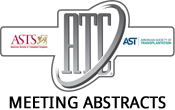2018 American Transplant Congress
IL-17 is Critical for Airway Epithelial Injury after Transplantation
Background: Obliterative bronchiolitis is the major obstacle limiting long-term allograft survival of lung transplantation. Airway epithelium is the primary target in obliterative airway diseases. Th17…2018 American Transplant Congress
Estimated Impact of the Number of Simultaneous Offers on Kidney Delay and Discard
Following local decline of a recovered kidney, making regional and national offers in larger simultaneous batches might decrease discards. We simulated varying batch sizes for…2018 American Transplant Congress
The Etiologies and Impact of Hospitalization in Older Kidney Transplant Recipients
Medical University of South Carolina, Charleston, SC.
Older kidney transplant recipients (KTR) face challenges of post-transplant complications related to frailty and comorbidities. They are particularly vulnerable to infectious complications. This study elucidates…2018 American Transplant Congress
The Risk Factors of Acute Rejection in Patients with BK Nephropathy after the Reduction of Immunosuppression
Background: BK nephropathy (BKN) affects graft function and increases the risk of graft failure. The reduction of immunosuppression is the main treatment for BKN. However,…2018 American Transplant Congress
Cost Effectiveness of Lifelong Medicare Immunosuppressant Drug Coverage for Kidney Transplant Recipients in the Current Era
While there is no Medicare time limit for dialysis patients, kidney transplant recipients lose their Medicare coverage 36 months after they receive their transplant. The…2018 American Transplant Congress
Recipient IFNAR1 Signaling Supports Costimulation Independent Rejection by Promoting T Cell Activation
Department of Surgery, Emory University, Atlanta, GA.
Costimulation blockade (CoB) is a promising strategy for more targeted/less toxic transplant immunosuppression which has led to the first improvement in long-term outcomes for transplant…2018 American Transplant Congress
Curative Correction of FAH Deficiency by Chimeric Stem Cells Transplantation
Fumarylacetoacetate hydrolase (FAH) deficient pigs have been proposed as surrogate hosts for large scale in vivo expansion of normal FAH+ hepatocytes. However, immunologic rejection prevents…2018 American Transplant Congress
Follow Up of Patients Treated with the IgG Endopeptidase (IdeS) for Desensitization and HLA Incompatible (HLAi) Kidney Transplantation
Introduction:Donor-specific antibodies (DSAs) create an immunologic barrier to transplantation. This prevents transplantation for a significant percentage of highly-HLA sensitized patients (HS). Current desensitization therapies are…2018 American Transplant Congress
Impact of Center Volume on Kidney Transplant Outcomes in Contemporary U.S. Transplant Practice
With the significant organ shortage, transplant professionals have expanded use of higher-risk deceased donor organs. The use of such organs requires surgical expertise and multidisciplinary…2018 American Transplant Congress
Effect of HLA Antibodies on Graft Survival in Adult Live Donor Liver Transplantation
The relevance of HLA antibodies in liver transplantation is currently being re-evaluated. While hyperacute rejections are not an issue, antibody effects on long-term outcomes are…
- « Previous Page
- 1
- …
- 15
- 16
- 17
- 18
- 19
- …
- 211
- Next Page »
